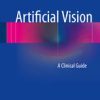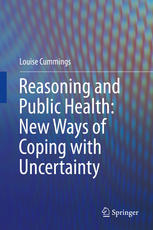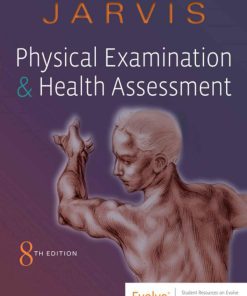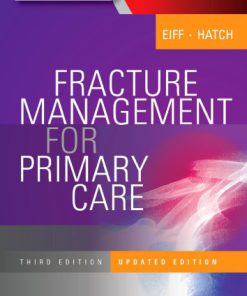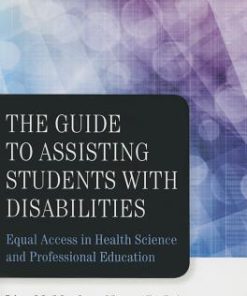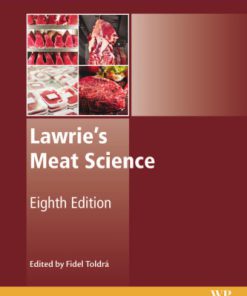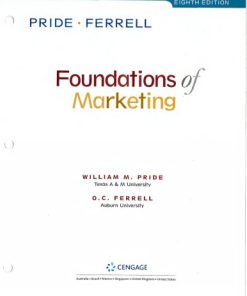DHO Health Science Updated 8th Edition by Louise Simmers, Karen Simmers Nartker 8214118604 9798214118604
$50.00 Original price was: $50.00.$25.00Current price is: $25.00.
DHO Health Science Updated 8th Edition by Louise M Simmers, Karen Simmers-Nartker – Ebook PDF Instant Download/DeliveryISBN: 8214118604, 9798214118604
Full download DHO Health Science Updated 8th Edition after payment.
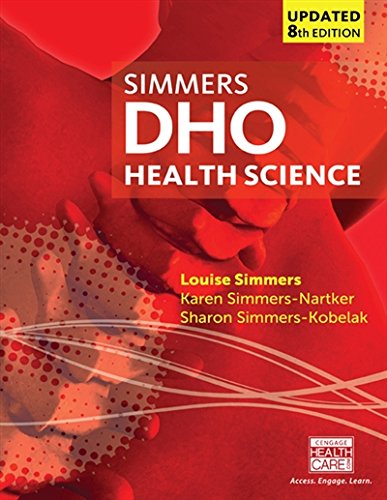
Product details:
ISBN-10 : 8214118604
ISBN-13 : 9798214118604
Author: Louise M Simmers, Karen Simmers-Nartker
This updated and enhanced seventh edition of ESSENTIALS OF METEOROLOGY is written by the most widely read and authoritative author in introductory meteorology-Donald Ahrens. Ahrens’s ability to explain relatively complicated ideas in a student-friendly, manageable fashion allows even non-science students to visualize the principles of meteorology. The text’s clear and inviting narrative is supplemented by numerous pedagogical features that encourage observing, calculating, and synthesizing information. New critical thinking questions linked to key figures and concept animation boxes point to online animations and appendices allowing students to immediately apply the text material to the world around them—and understand the underlying meteorological principles.
DHO Health Science Updated 8th Table of contents:
Part 1. Basic Health Care Concepts and Skills
1. History and Trends of Health Care
1:1. History of Health Care
Ancient Times
The Dark Ages and Middle Ages
The Renaissance
The 16th, 17th, and 18th Centuries
The 19th Century
The 20th Century
The 21st Century
1:2. Trends in Health Care
Cost Containment
Home Health Care
Geriatric Care
Telemedicine
Wellness
Complementary and Alternative Methods of Health Care
Pandemic
Biotechnologies
Conclusion
Today’s Research/Tomorrow’s Health Care — The Food and Drug Administration Regulating Maggots and Leeches as Medical Devices?
Chapter 1 Summary
Internet Searches
Review Questions
2. Health Care Systems
2:1. Private Health Care Facilities
Hospitals
Long-Term Care Facilities
Medical Offices
Concierge Medicine
Dental Offices
Clinics or Satellite Centers
Optical Centers
Emergency Care Services
Laboratories
Home Health Care
Hospice
Mental Health Facilities
Genetic Counseling Centers
Rehabilitation Facilities
Health Maintenance Organizations
Industrial Health Care Centers
School Health Services
Pharmaceutical Services
2:2. Government Agencies
2:3. Voluntary or Nonprofit Agencies
2:4. Organizational Structure
2:5. Health Insurance Plans
Today’s Research/Tomorrow’s Health Care — Nature as a Pharmacy?
Chapter 2 Summary
Internet Searches
Review Questions
3. Careers in Health Care
3:1. Introduction to Health Care Careers
Certification, Registration, and Licensure
Accreditation
Continuing Education Units
Professional Organizations
Education Levels, Trends, and Opportunities
National Healthcare Standards
Introduction to Health Care Careers
3:2. Therapeutic Services Careers
3:2A. Dental Careers
Additional Sources of Information
3:2B. Emergency Medical Services Careers
Additional Sources of Information
3:2C. Medical Careers
Additional Sources of Information
3:2D. Mental Health Services and Social Services Careers
Additional Sources of Information
3:2E. Mortuary Careers
Additional Sources of Information
3:2F. Nursing Careers
Additional Sources of Information
3:2G. Nutrition and Dietary Services Careers
Additional Sources of Information
3:2H. Veterinary Careers
Additional Sources of Information
3:2I. Vision Services Careers
Additional Sources of Information
3:2J. Other Therapeutic Services Careers
Additional Sources of Information
3:3. Diagnostic Services Careers
Additional Sources of Information
3:4. Health Informatics Careers
Additional Sources of Information
3:5. Support Services Careers
Additional Sources of Information
3:6. Biotechnology Research and Development Careers
Additional Sources of Information
Today’s Research/Tomorrow’s Health Care — Memories Restored by Flipping a Switch?
Chapter 3 Summary
Internet Searches
Review Questions
4. Personal and Professional Qualities of a Health Care Worker
Introduction
4:1. Personal Appearance
Good Health
Professional Appearance
4:2. Personal Characteristics
4:3. Effective Communications
Communication Process
Listening
Nonverbal Communication
Barriers to Communication
Recording and Reporting
Summary
4:4. Interpersonal Relationships
4:5. Teamwork
4:6. Professional Leadership
4:7. Parliamentary Procedure
4:8. Stress
4:9. Time Management
Setting Goals
Time Management Plan
Today’s Research/Tomorrow’s Health Care — Billions of Bacteria Living in the Crook of Your Elbow?
Chapter 4 Summary
Internet Searches
Review Questions
5. Legal and Ethical Responsibilities
5:1. Legal Responsibilities
Introduction
Torts
Contracts
Privileged Communications
Privacy Act
Regulation of Health Care Providers
5:2. Ethics
5:3. Patients’ Rights
5:4. Advance Directives for Health Care
5:5. Professional Standards
Today’s Research/Tomorrow’s Health Care — Frozen Stem Cells That Cure Major Diseases?
Chapter 5 Summary
Internet Searches
Review Questions
6. Medical Terminology
6:1. Interpreting Word Parts
6:2. Using Medical Abbreviations
Miscellaneous Symbols
Today’s Research/Tomorrow’s Health Care — Artificial Red Blood Cells That Replace the Need for Blood Transfusions?
Chapter 6 Summary
Internet Searches
Review Questions
7. Anatomy and Physiology
7:1. Basic Structure of the Human Body
Objectives
Introduction
Cells
Tissue
Organs and Systems
7:2. Body Planes, Directions, and Cavities
Objectives
Introduction
Body Planes
Body Cavities
Abdominal Regions
7:3. Integumentary System
Objectives
Introduction
Functions
Pigmentation
Skin Eruptions
Diseases and Abnormal Conditions
7:4. Skeletal System
Objectives
Introduction
Diseases and Abnormal Conditions
7:5. Muscular System
Objectives
Introduction
Diseases and Abnormal Conditions
7:6. Nervous System
Objectives
Introduction
Central Nervous System
Peripheral Nervous System
Diseases and Abnormal Conditions
7:7. Special Senses
Objectives
Introduction
The Eye
The Ear
The Tongue and Sense of Taste
The Nose and Sense of Smell
The Skin and General Senses
7:8. Circulatory System
Objectives
Introduction
The Heart
Blood Vessels
Blood Composition
Diseases and Abnormal Conditions
7:9. Lymphatic System
Objectives
Introduction
Diseases and Abnormal Conditions
7:10. Respiratory System
Objectives
Introduction
Respiratory Organs and Structures
Process of Breathing
Stages of Respiration
Diseases and Abnormal Conditions
7:11. Digestive System
Objectives
Introduction
Parts of the Alimentary Canal
Accessory Organs
Diseases and Abnormal Conditions
7:12. Urinary System
Objectives
Introduction
Diseases and Abnormal Conditions
7:13. Endocrine System
Objectives
Introduction
Pituitary Gland
Thyroid Gland
Parathyroid Glands
Adrenal Glands
Pancreas
Other Endocrine Glands
7:14. Reproductive System
Objectives
Introduction
Male Reproductive System
Female Reproductive System
Sexually Transmitted Infections
Today’s Research/Tomorrow’s Health Care — Body Organs That Are Grown in the Laboratory?
Chapter 7 Summary
Internet Searches
Review Questions
8. Human Growth and Development
Introduction
8:1. Life Stages
Infancy
Early Childhood
Late Childhood
Adolescence
Early Adulthood
Middle Adulthood
Late Adulthood
8:2. Death and Dying
Stages of Dying and Death
Hospice Care
Right to Die
8:3. Human Needs
Maslow’s Hierarchy of Needs
Meeting Needs
Methods of Satisfying Human Needs
Today’s Research/Tomorrow’s Health Care — A Microchip to Cure Diabetic Retinopathy?
Chapter 8 Summary
Internet Searches
Review Questions
9. Cultural Diversity
9:1. Culture, Ethnicity, and Race
9:2. Bias, Prejudice, and Stereotyping
9:3. Understanding Cultural Diversity
Family Organization
Language
Personal Space and Touch
Time Orientation
Eye Contact
Gestures
Health Care Beliefs
Spirituality and Religion
9:4. Respecting Cultural Diversity
Today’s Research/Tomorrow’s Health Care — A Computer Microchip That Uses an Individual’s Cultural and Genetic Factors to Determine What Medication the Person Needs?
Chapter 9 Summary
Internet Searches
Review Questions
10. Geriatric Care
Introduction
10:1. Myths on Aging
10:2. Physical Changes of Aging
Integumentary System
Musculoskeletal System
Circulatory System
Respiratory System
Nervous System
Digestive System
Urinary System
Endocrine System
Reproductive System
Summary
10:3. Psychosocial Changes of Aging
Work and Retirement
Social Relationships
Living Environments
Independence
Disease and Disability
Summary
10:4. Confusion and Disorientation in the Elderly
Causes of Confusion and Disorientation
Caring for Confused or Disoriented Individuals
10:5. Meeting the Needs of the Elderly
Today’s Research/Tomorrow’s Health Care — People Living to 200 Years of Age?
Chapter 10 Summary
Internet Searches
Review Questions
11. Nutrition and Diets
11:1. Fundamentals of Nutrition
11:2. Essential Nutrients
Carbohydrates
Lipids (Fats)
Proteins
Vitamins
Minerals
Water
11:3. Utilization of Nutrients
Digestion
Absorption
Metabolism
11:4. Maintenance of Good Nutrition
11:5. Weight Management
Underweight and Overweight
Measuring Food Energy
Managing Weight
11:6. Therapeutic Diets
Regular Diet
Liquid Diets
Soft Diet
Diabetic Diet
Calorie-Controlled Diets
Low-Cholesterol Diet
Fat-Restricted Diets
Sodium-Restricted Diets
Protein Diets
Bland Diet
Fiber Diets
Other Diets
Today’s Research/Tomorrow’s Health Care — A Daily Pill That Prevents Cardiovascular Disease and Alzheimer’s Disease?
Chapter 11 Summary
Internet Searches
Review Questions
12. Computers and Technology in Health Care
12:1. Introduction
12:2. Information Systems
12:3. Diagnostics
Medical Laboratory Tests
Cardiac Tests
Imaging Technology
Summary
12:4. Treatment
12:5. Patient Monitoring
12:6. Education
12:7. Research
12:8. Communication
12:9. Using the Internet
12:10. Computer Protection and Security
Today’s Research/Tomorrow’s Health Care — Medication via Remote Control Instead of an Injection?
Chapter 12 Summary
Internet Searches
Review Questions
13. Medical Math
Introduction
13.1. Basic Calculations
Whole Numbers
Decimals
Fractions
Percentages
Ratios
Converting Decimals, Fractions, Percentages, and Ratios
Rounding Numbers
Solving Problems with Proportions
13.2. Estimating
13.3. Roman Numerals
13:4. Angles
13:5. Systems of Measurement
Household System
Metric System
Apothecary System
Converting Systems of Measurement
13:6. Temperature Conversion
13:7. Military Time
Today’s Research/Tomorrow’s Health Care — Scorpions and Snakes to Cure Cancer?
Chapter 13 Summary
Internet Searches
Review Questions
14. Promotion of Safety
14:1. Using Body Mechanics
Procedure 14:1. Using Body Mechanics
14:2. Preventing Accidents and Injuries
Chemical Hazards
Bloodborne Pathogen Standard
Environmental Safety
Procedure 14:2. Preventing Accidents and Injuries
14:3. Observing Fire Safety
Fire Extinguishers
Fire Emergency Plan
Disaster Plans
Procedure 14:3. Observing Fire Safety
Today’s Research/Tomorrow’s Health Care — Draino for Blood Vessels?
Chapter 14 Summary
Internet Searches
Review Questions
15. Infection Control
15:1. Understanding the Principles of Infection Control
Classes of Microorganisms
Types of Infection
Chain of Infection
Aseptic Techniques
15:2. Bioterrorism
Introduction
Biologic Agents
Preparing for Bioterrorism
15:3. Washing Hands
Procedure 15:3. Washing Hands
15:4. Observing Standard Precautions
Bloodborne Pathogens Standard
Needlestick Safety Act
Standard Precautions
Procedure 15:4. Observing Standard Precautions
15:5. Sterilizing with an Autoclave
Procedure 15:5A. Wrapping Items for Autoclaving
Procedure 15:5B. Loading and Operating an Autoclave
15:6. Using Chemicals for Disinfection
Procedure 15:6. Using Chemicals for Disinfection
15:7. Cleaning with an Ultrasonic Unit
Procedure 15:7. Cleaning with an Ultrasonic Unit
15:8. Using Sterile Techniques
Procedure 15.8A. Opening Sterile Packages
Procedure 15:8B. Preparing a Sterile Dressing Tray
Procedure 15:8C. Donning and Removing Sterile Gloves
Procedure 15.8D. Changing a Sterile Dressing
15:9. Maintaining Transmission-Based Precautions
Introduction
Standard Precautions
Airborne Precautions
Droplet Precautions
Contact Precautions
Ebola Virus Disease (EVD) Precautions
Protective or Reverse Isolation
Summary
Procedure 15:9A. Donning and Removing Transmission-Based Isolation Garments
Procedure 15:9B. Working in a Hospital Transmission-Based Isolation Unit
Today’s Research/Tomorrow’s Health Care — Paint Away Those Germs?
Chapter 15 Summary
Internet Searches
Review Questions
16. Vital Signs
16:1. Measuring and Recording Vital Signs
16:2. Measuring and Recording Temperature
Variations in Body Temperature
Types of Thermometers
Reading and Recording Temperature
Cleaning Thermometers
Procedure 16:2A. Measuring and Recording Oral Temperature with a Clinical Thermometer
Procedure 16:2B. Measuring Oral Temperature with an Electronic Thermometer
Procedure 16:2C. Measuring and Recording Rectal Temperature
Procedure 16:2D. Measuring and Recording Axillary Temperature
Procedure 16:2E. Measuring and Recording Tympanic (Aural) Temperature
Procedure 16:2F. Measuring and Recording Temporal Temperature
16:3. Measuring and Recording Pulse
Procedure 16:3. Measuring and Recording Radial Pulse
16:4. Measuring and Recording Respirations
Procedure 16:4. Measuring and Recording Respirations
16:5. Graphing TPR
Procedure 16:5. Graphing TPR
16:6. Measuring and Recording Apical Pulse
Procedure 16:6. Measuring and Recording Apical Pulse
16:7. Measuring and Recording Blood Pressure
Procedure 16:7. Measuring and Recording Blood Pressure
Today’s Research/Tomorrow’s Health Care — An Artificial Heart That Eliminates the Need for Heart Transplants?
Chapter 16 Summary
Internet Searches
Review Questions
17. First Aid
17:1. Providing First Aid
Introduction
Basic Principles of First Aid
Summary
17:2. Performing Cardiopulmonary Resuscitation
Introduction
Components of CPR
Basic Principles of CPR
CPR for Adults, Infants, and Children
Choking Victims
Procedure 17:2A. Performing CPR—One-Person Adult Rescue
Procedure 17:2B. Performing CPR—Two-Person Adult Rescue
Procedure 17:2C. Performing CPR on Infants
Procedure 17:2D. Performing CPR on Children
Procedure 17:2E. Performing CPR—Obstructed Airway on Conscious Adult or Child
Procedure 17:2F. Performing CPR—Obstructed Airway on Conscious Infant
17:3. Providing First Aid for Bleeding and Wounds
Introduction
Types of Open Wounds
Controlling Bleeding
Minor Wounds
Closed Wounds
Summary
Procedure 17:3. Providing First Aid for Bleeding and Wounds
17:4. Providing First Aid for Shock
Introduction
Causes of Shock
Signs and Symptoms
Treatment for Shock
Procedure 17:4. Providing First Aid for Shock
17:5. Providing First Aid for Poisoning
Introduction
Ingestion Poisoning
Inhalation Poisoning
Contact Poisoning
Injection Poisoning
Summary
Procedure 17:5. Providing First Aid for Poisoning
17:6. Providing First Aid for Burns
Types of Burns
Treatment
Summary
Procedure 17:6. Providing First Aid for Burns
17:7. Providing First Aid for Heat Exposure
Procedure 17:7. Providing First Aid for Heat Exposure
17:8. Providing First Aid for Cold Exposure
Procedure 17:8. Providing First Aid for Cold Exposure
17:9. Providing First Aid for Bone and Joint Injuries
Fractures
Dislocations
Sprains
Strains
Splints
Slings
Neck and Spine Injuries
Summary
Procedure 17:9. Providing First Aid for Bone and Joint Injuries
17:10. Providing First Aid for Specific Injuries
Eye Injuries
Ear Injuries
Head or Skull Injuries
Nose Injuries
Chest Injuries
Abdominal Injuries
Injuries to Genital Organs
Summary
Procedure 17:10. Providing First Aid for Specific Injuries
17:11. Providing First Aid for Sudden Illness
Heart Attack
Cerebrovascular Accident or Stroke
Fainting
Convulsion
Diabetic Reactions
Summary
Procedure 17:11. Providing First Aid for Sudden Illness
17:12. Applying Dressings and Bandages
Procedure 17:12. Applying Dressings and Bandages
Today’s Research/Tomorrow’s Health Care — A Skin Gun to Treat Burns?
Chapter 17 Summary
Internet Searches
Review Questions
18. Preparing for the World of Work
18:1. Developing Job-Keeping Skills
Preparing for a Job
Characteristics of a Good Employee
Resigning from a Job
18:2. Writing a Cover Letter and Preparing a Résumé
Introduction
Cover Letter
Résumé
Career Passport or Portfolio
Procedure 18:2. Writing a Cover Letter and Preparing a Résumé
18:3. Completing Job Application Forms
Procedure 18:3. Completing Job Application Forms
18:4. Participating in a Job Interview
Procedure 18:4. Participating in a Job Interview
18:5. Determining Net Income
Procedure 18:5. Determining Net Income
18:6. Calculating a Budget
Procedure 18:6. Calculating a Budget
Today’s Research/Tomorrow’s Health Care — A Bravery Gene?
Chapter 18 Summary
Internet Searches
Review Questions
Part 2. Special Health Care Skills
19. Dental Assistant Skills
19:1. Identifying the Structures and Tissues of a Tooth
Procedure 19:1. Identifying the Structures and Tissues of a Tooth
19:2. Identifying the Teeth
Procedure 19:2. Identifying the Teeth
19:3. Identifying Teeth Using the Universal/National Numbering System and the Federation Dentaire International (FDI) System
Procedure 19:3A. Identifying Teeth Using the Universal/National Numbering System
Procedure 19:3B. Identifying Teeth Using the Federation Dentaire International (FDI) Numbering System
19:4. Identifying the Surfaces of the Teeth
Procedure 19:4. Identifying the Surfaces of the Teeth
19:5. Charting Conditions of the Teeth
Procedure 19:5. Charting Conditions of the Teeth
19:6. Operating and Maintaining Dental Equipment
Procedure 19:6. Operating and Maintaining Dental Equipment
19:7. Identifying Dental Instruments and Preparing Dental Trays
Procedure 19:7. Identifying Dental Instruments and Preparing Dental Trays
19:8. Positioning a Patient in the Dental Chair
Procedure 19:8. Positioning a Patient in the Dental Chair
19:9. Demonstrating Brushing and Flossing Techniques
Procedure 19:9A. Demonstrating Brushing Technique
Procedure 19:9B. Demonstrating Flossing Technique
19:10. Taking Impressions and Pouring Models
Introduction
Alginate
Rubber Base (Polysulfide)
Silicones
Gypsum Materials
Procedure 19:10A. Preparing Alginate
Procedure 19:10B. Preparing Rubber Base (Polysulfide)
Procedure 19:10C. Pouring a Plaster Model
Procedure 19:10D. Pouring a Stone Model
Procedure 19:10E. Trimming a Model
19:11. Making Custom Trays
Procedure 19:11. Making Custom Trays
19:12. Maintaining and Loading an Anesthetic Aspirating Syringe
Procedure 19:12A. Maintaining an Anesthetic Aspirating Syringe
Procedure 19:12B. Loading an Anesthetic Aspirating Syringe
19:13. Mixing Dental Cements and Bases
Procedure 19:13A. Preparing Varnish
Procedure 19:13B. Preparing Calcium Hydroxide
Procedure 19:13C. Preparing Polycarboxylate
Procedure 19:13D. Preparing Zinc Oxide Eugenol (ZOE)
19.14. Preparing Restorative Materials—Amalgam and Composite
Amalgam
Composite
Procedure 19:14A. Preparing Amalgam
Procedure 19:14B. Preparing Composite
19:15. Developing and Mounting Dental Radiographs (X-Rays)
Procedure 19:15A. Developing Dental Radiographs (X-rays)
Procedure 19:15B. Mounting Dental Radiographs (X-rays)
Today’s Research/Tomorrow’s Health Care — Tissue Engineering of Pulp to Replace Endodontics?
Chapter 19 Summary
Internet Searches
Review Questions
20. Laboratory Assistant Skills
20:1. Operating the Microscope
Procedure 20:1. Operating the Microscope
20:2. Obtaining and Handling Cultures
Procedure 20:2A. Obtaining a Culture Specimen
Procedure 20:2B. Preparing a Direct Smear
Procedure 20:2C. Streaking an Agar Plate
Procedure 20:2D. Transferring Culture from Agar Plate to Slide
Procedure 20:2E. Staining with Gram’s Stain
20:3. Puncturing the Skin to Obtain Capillary Blood
Procedure 20:3. Puncturing the Skin to Obtain Capillary Blood
20:4. Performing a Microhematocrit
Procedure 20:4. Performing a Microhematocrit
20:5. Measuring Hemoglobin
Procedure 20:5. Measuring Hemoglobin with a Hemoglobinometer
20:6. Preparing and Staining a Blood Film or Smear
Procedure 20:6A. Preparing a Blood Film or Smear
Procedure 20:6B. Staining a Blood Film or Smear
20:7. Testing for Blood Types
Procedure 20:7. Testing for Blood Types
20:8. Performing an Erythrocyte Sedimentation Rate
Procedure 20:8. Performing an Erythrocyte Sedimentation Rate
20:9. Measuring Blood-Sugar (Glucose) Level
Procedure 20:9. Measuring Blood-Sugar (Glucose) Level
20:10. Testing Urine
20:11. Using Reagent Strips to Test Urine
Procedure 20:11. Using Reagent Strips to Test Urine
20:12. Measuring Specific Gravity
Procedure 20:12. Measuring Specific Gravity
20:13. Preparing Urine for Microscopic Examination
Procedure 20:13. Preparing Urine for Microscopic Examination
Today’s Research/Tomorrow’s Health Care — No More Blood and Urine Tests? Just Use Tears, Sweat, and Saliva!
Chapter 20 Summary
Internet Searches
Review Questions
21. Medical Assistant Skills
21:1. Measuring/Recording Height and Weight
Procedure 21:1A. Measuring/Recording Height and Weight
Procedure 21:1B. Measuring/Recording Height and Weight of an Infant
21:2. Positioning a Patient
Procedure 21:2. Positioning a Patient
21:3. Screening for Vision Problems
Procedure 21:3. Screening for Vision Problems
21:4. Assisting with Physical Examinations
Procedure 21:4A. Eye, Ear, Nose, and Throat Examination
Procedure 21:4B. Assisting with a Gynecological Examination
Procedure 21:4C. Assisting with a General Physical Examination
21:5. Assisting with Minor Surgery and Suture Removal
Procedure 21:5A. Assisting with Minor Surgery
Procedure 21:5B. Assisting with Suture Removal
21:6. Recording and Mounting an Electrocardiogram
Procedure 21:6. Recording and Mounting an Electrocardiogram
21:7. Using the Physicians’ Desk Reference (PDR)
Procedure 21:7. Using the Physicians’ Desk Reference (PDR)
21:8. Working with Medications
Today’s Research/Tomorrow’s Health Care — The Nose Knows Cancer?
Chapter 21 Summary
Internet Searches
Review Questions
22. Nurse Assistant Skills
22:1. Admitting, Transferring, and Discharging Patients
Procedure 22:1A. Admitting the Patient
Procedure 22:1B. Transferring the Patient
Procedure 22:1C. Discharging the Patient
22:2. Positioning, Turning, Moving, and Transferring Patients
Alignment
Turning
Dangling
Transfers
Procedure 22:2A. Aligning the Patient
Procedure 22:2B. Moving the Patient Up in Bed
Procedure 22:2C. Turning the Patient Away to Change Position
Procedure 22:2D. Turning the Patient Inward to Change Position
Procedure 22:2E. Sitting Up to Dangle
Procedure 22:2F. Transferring a Patient to a Chair or Wheelchair
Procedure 22:2G. Transferring a Patient to a Stretcher
Procedure 22:2H. Using a Mechanical Lift to Transfer a Patient
22:3. Bedmaking
Procedure 22:3A. Making a Closed Bed
Procedure 22:3B. Making an Occupied Bed
Procedure 22:3C. Opening a Closed Bed
Procedure 22:3D. Placing a Bed Cradle
22:4. Administering Personal Hygiene
Types of Baths
Oral Hygiene
Hair Care
Nail Care
Shaving
Back Rub
Changing a Gown or Clothing
Summary
Procedure 22:4A. Providing Routine Oral Hygiene
Procedure 22:4B. Cleaning Dentures
Procedure 22:4C. Giving Special Mouth Care
Procedure 22:4D. Administering Daily Hair Care
Procedure 22:4E. Providing Nail Care
Procedure 22:4F. Giving a Backrub
Procedure 22:4G. Shaving a Patient
Procedure 22:4H. Changing a Patient’s Gown or Pajamas
Procedure 22:4I. Giving a Complete Bed Bath
Procedure 22:4J. Helping a Patient Take a Tub Bath or Shower
22:5. Measuring and Recording Intake and Output
Intake
Output
Recording Intake and Output (I&O)
Procedure 22:5. Recording Intake and Output
22:6. Feeding a Patient
Procedure 22:6. Feeding a Patient
22:7. Assisting with a Bedpan/Urinal
Procedure 22:7A. Assisting with a Bedpan
Procedure 22:7B. Assisting with a Urinal
22:8. Providing Catheter and Urinary-Drainage Unit Care
Procedure 22:8A. Providing Catheter Care
Procedure 22:8B. Emptying a Urinary-Drainage Unit
22:9. Providing Ostomy Care
Procedure 22:9. Providing Ostomy Care
22:10. Collecting Stool/Urine Specimens
Routine Urine Specimen
Clean-Catch, or Midstream-Voided, Specimen
Catheterization for Sterile Urine Specimen
24-Hour Urine Specimens
Routine Stool Specimen
Stool for Occult Blood
Summary
Procedure 22:10A. Collecting a Routine Urine Specimen
Procedure 22:10B. Collecting a Midstream Urine Specimen
Procedure 22:10C. Collecting a 24-Hour Urine Specimen
Procedure 22:10D. Collecting a Stool Specimen
Procedure 22:10E. Preparing and Testing a Hemoccult Slide
22:11. Enemas and Rectal Treatments
Procedure 22:11A. Giving a Tap-Water, Normal Saline, or Soap-Solution Enema
Procedure 22:11B. Giving a Disposable Enema
Procedure 22:11C. Giving an Oil-Retention Enema
Procedure 22:11D. Inserting a Rectal Tube
22:12. Applying Restraints
Procedure 22:12A. Applying Limb Restraints
Procedure 22:12B. Applying a Jacket Restraint
22:13. Administering Preoperative and Postoperative Care
Preoperative Care
Anesthesia
Postoperative Care
Summary
Procedure 22:13A. Shaving the Operative Area
Procedure 22:13B. Administering Preoperative Care
Procedure 22:13C. Preparing a Postoperative Unit
Procedure 22:13D. Applying Surgical Hose and Compression Stockings
22:14. Applying Binders
Procedure 22:14. Applying a Straight Binder
22:15. Administering Oxygen
Methods of Oxygen Administration
Oxygen Delivery Systems
Safety Precautions
Pulse Oximeters
Summary
Procedure 22:15. Administering Oxygen
22:16. Giving Postmortem Care
Procedure 22:16. Giving Postmortem Care
Today’s Research/Tomorrow’s Health Care — Gene Therapy That Cures Cancer?
Chapter 22 Summary
Internet Searches
Review Questions
23. Physical Therapy Skills
23:1. Performing Range-of-Motion (ROM) Exercises
Procedure 23:1. Performing Range-of-Motion (ROM) Exercises
23:2. Ambulating Patients Who Use Transfer (Gait) Belts, Crutches, Canes, or Walkers
Transfer (Gait) Belt
Crutches
Cane
Walker
Ambulation Precautions
Procedure 23:2A. Ambulating a Patient with a Transfer (Gait) Belt
Procedure 23:2B. Ambulating a Patient Who Uses Crutches
Procedure 23:2C. Ambulating a Patient Who Uses a Cane
Procedure 23:2D. Ambulating a Patient Who Uses a Walker
23:3. Administering Heat/Cold Applications
Procedure 23:3A. Applying an Ice Bag or Ice Collar
Procedure 23:3B. Applying a Warm-Water Bag
Procedure 23:3C. Applying an Aquathermia Pad
Procedure 23:3D. Applying a Moist Compress
Procedure 23:3E. Administering a Sitz Bath
Today’s Research/Tomorrow’s Health Care — Rewire the Brain to Treat Tinnitus?
Chapter 23 Summary
Internet Searches
Review Questions
24. Business and Accounting Skills
24:1A. Filing Records
Types of Filing Systems
Cross-Indexes or -References
Color-Coded Filing Systems
Storage of Files
Electronic Health Records
24:1B. Filing Records Using the Alphabetical or Numerical System
Alphabetical Filing
Numerical Filing
Procedure 24.1. Filing Records Using the Alphabetical or Numerical System
24:2. Using the Telephone
Basic Telephone Techniques
Automatic Routing Telephone Systems
Answering Services and Machines
Paging Systems
Cellular Telephones
Electronic Mail
Fax (Facsimile) Machines
Procedure 24.2. Using the Telephone
24:3. Scheduling Appointments
Procedure 24.3. Scheduling Appointments
24:4. Completing Medical Records and Forms
Procedure 24:4. Completing Medical Records and Forms
24:5. Composing Business Letters
Types of Letters
Parts of a Letter
Proper Form for Letters
Summary
Procedure 24:5. Composing Business Letters
24:6. Completing Insurance Forms
Coding Insurance Forms
Completing Insurance Claims
Procedure 24:6. Completing Insurance Forms
24:7. Maintaining a Bookkeeping System
Pegboard System
Computerized Bookkeeping Systems
Procedure 24:7. Maintaining a Bookkeeping System
24:8. Writing Checks, Deposit Slips, and Receipts
Procedure 24:8A. Writing Checks
Procedure 24:8B. Writing Deposit Slips
Procedure 24:8C. Writing Receipts
Today’s Research/Tomorrow’s Health Care — Bionic Peepers?
Chapter 24 Summary
Internet Searches
Review Questions
People also search for DHO Health Science Updated 8th:
dho health science pdf
dho health science book
dho health science chapter 1
a health science degree
dho health science book pdf
Tags: DHO Health, Science, Louise Simmers, Karen Simmers Nartker
You may also like…
Science (General)
Reasoning and Public Health New Ways of Coping with Uncertainty 1st Edition Louise Cummings (Auth.)
History - European History
Medieval Dress and Textiles in Britain: A Multilingual Sourcebook Louise M. Sylvester
Medicine - Anatomy and physiology
Physical Examination and Health Assessment 8th Edition Carolyn Jarvis
Technique - Food Manufacturing
Business & Economics
Foundations Of Marketing 8th Ed. 8th Edition William M. Pride
Education Studies & Teaching - Educational Guidance & Counseling
Educational Assessment of Students 8th Edition Susan M. Brookhart



